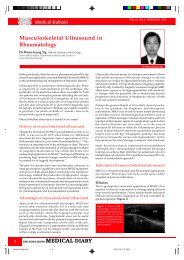MEDICAL DIARY - The Federation of Medical Societies of Hong Kong
MEDICAL DIARY - The Federation of Medical Societies of Hong Kong
MEDICAL DIARY - The Federation of Medical Societies of Hong Kong
You also want an ePaper? Increase the reach of your titles
YUMPU automatically turns print PDFs into web optimized ePapers that Google loves.
18<br />
Introduction<br />
<strong>Medical</strong> Bulletin<br />
Current Results <strong>of</strong> Treatment <strong>of</strong> Head and<br />
Neck Surgery<br />
Dr. Yu-wai Chan<br />
MBBS(HK), MRCSEd, FCSHK, FHKAM(Surgery<br />
Department <strong>of</strong> Surgery, University <strong>of</strong> <strong>Hong</strong> <strong>Kong</strong> <strong>Medical</strong> Centre, Queen Mary Hospital, <strong>Hong</strong> <strong>Kong</strong><br />
Head and neck surgery deals with pathologies, both<br />
benign and malignant. <strong>The</strong>se lesions can be located<br />
anywhere from the skull base to the oral cavity down to<br />
the lower neck including the upper mediastinum. <strong>The</strong><br />
availability <strong>of</strong> advanced diagnostic strategies, for<br />
example CT scan, MRI and PET scan, as well as<br />
improved therapeutic measures result in better local and<br />
regional control <strong>of</strong> disease, on the other hand, without<br />
scarifying the quality <strong>of</strong> life for patients. <strong>The</strong>se can only<br />
be achieved by close collaboration between surgeons and<br />
other specialties, including diagnostic radiology, clinical<br />
oncology, pathology, physiology as well as speech<br />
therapy.<br />
Advances in surgical resection<br />
Surgical approaches for tumour extirpation<br />
Access to certain anatomical areas <strong>of</strong> the head and neck<br />
region is notoriously difficult and adequate exposure for<br />
surgery in these areas poses particular challenges to<br />
surgeons. Examples include tumours situated at the<br />
nasopharynx and anterior skull base.<br />
<strong>The</strong> anterolateral approach to the nasopharynx using<br />
maxillary swing operation for surgical resection <strong>of</strong><br />
recurrent nasopharyngeal carcinoma was first<br />
introduced by Pr<strong>of</strong>essor William I. Wei in 1991 1.<strong>The</strong><br />
advantage <strong>of</strong> this approach is that it <strong>of</strong>fers a wide<br />
exposure <strong>of</strong> the whole nasopharynx and parapharyngeal<br />
space for an adequate oncologic surgical procedure.<br />
After resection is complete, the facial skeleton is restored<br />
by returning the maxillary osteocutaneous flap and fixing<br />
with titanium microplates. After curative resection, a 5year<br />
local tumour control rate <strong>of</strong> 62% can be achieved 2.<br />
Anterior skull base tumours <strong>of</strong>ten necessitate cooperation<br />
between head and neck surgeons and<br />
neurosurgeons for surgical resection. A combined<br />
crani<strong>of</strong>acial approach has been used via a bicoronal scalp<br />
incision and midface deglove incision, resulting in an<br />
adequate exposure <strong>of</strong> the region. Adequate tumour<br />
resection with long-term survival is possible 3.<br />
Tools for tumour extirpation<br />
<strong>The</strong> advent <strong>of</strong> technology has significantly improved the<br />
results <strong>of</strong> many surgical procedures. Ultrasonic-activated<br />
surgical instruments have been widely used in recent<br />
years, especially in minimally invasive endoscopic<br />
abdominal and thoracic procedures. Its use in head and<br />
neck regions has been reported, for example tonsillectomy,<br />
VOL.12 NO.7 JULY 2007<br />
submandibular sialoadenectomy and thyroidectomy. <strong>The</strong><br />
use <strong>of</strong> ultrasonic scissors in glossectomy for patients with<br />
carcinoma <strong>of</strong> tongue was proven successful, due to the<br />
benefit <strong>of</strong> combined effect <strong>of</strong> cutting and haemostasis. <strong>The</strong><br />
median blood loss in our series <strong>of</strong> patients was zero 4.<br />
In patients with early glottic tumour, it was well known<br />
that radiotherapy allows organ preservation while<br />
achieving similar local tumour control rate comparing to<br />
laryngectomy. However, it is <strong>of</strong>ten associated with<br />
changes in quality <strong>of</strong> voice, which significantly affects the<br />
quality <strong>of</strong> life <strong>of</strong> these patients. Endoscopic CO2 laser<br />
cordectomy in early glottic cancers <strong>of</strong>fers good oncologic<br />
results with rapid post-operative recovery as well as<br />
superior voice outcomes, especially with subepithelial<br />
(type I) and subligamentous (type II) cordectomies 5.<br />
Management <strong>of</strong> clinically N0 neck <strong>of</strong> head and<br />
neck malignancy<br />
<strong>The</strong> management <strong>of</strong> clinically N0 cervical nodal status in<br />
patients with head and neck malignancy continues to be<br />
a subject <strong>of</strong> debate in the literature. Oral tongue<br />
carcinoma is well known for its propensity <strong>of</strong> subclinical<br />
nodal micrometastasis in stage I and II tumours, and<br />
these are, unfortunately, not detectable by the best<br />
diagnostic technology. Locoregional recurrence is the<br />
main cause <strong>of</strong> treatment failures <strong>of</strong> carcinoma <strong>of</strong> tongue 6.<br />
In our series, tumour thickness was the only significant<br />
factor that had predictive value for subclinical nodal<br />
metastasis, local recurrence and survival 7. Tumour up to<br />
3mm in thickness has 8% subclinical nodal metastasis<br />
and these patients will be followed up closely to detect<br />
possible regional recurrence; tumour more than 3mm<br />
and up to 9mm thick had 44% subclinical nodal<br />
metastasis and for these patients, elective selective neck<br />
dissection should be <strong>of</strong>fered; tumour more than 9mm<br />
thick had 53% subclinical nodal metastasis, and in these<br />
patients the large size primary tumour warrants postoperation<br />
adjuvant radiotherapy, the neck can therefore<br />
be irradiated together with the oral cavity.<br />
Advances in reconstruction<br />
Dr. Yu-wai Chan<br />
Advances <strong>of</strong> head and neck reconstruction have<br />
improved the functional and aesthetic outcome <strong>of</strong><br />
patients following extensive surgical resection. Before the<br />
era <strong>of</strong> microvascular free tissue transfer, pectoralis major<br />
myocutaneous flap, first described by Ariayan in 1979 8,<br />
has been the workhorse for head and neck<br />
reconstruction. Although it has been proven to be reliable<br />
and versatile, it has several limitations, including large
















